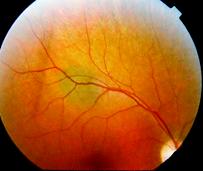
Has your eye doctor said your choroidal nevus is bigger?
Though it’s uncommon for a choroidal nevus to become a melanoma, all eye melanomas were once a choroidal nevus.
What is a choroidal nevus?
It’s a mole or freckle in the back of the eye that the patient cannot see, and would not know is there unless an ophthalmologist spotted it with a viewing instrument.
It is not a birthmark, because people are not born with these pigmented lesions.
They are rare in childhood, but along the way, begin developing such that at some point, an ophthalmologist may discover it.
It’s estimated that two to 13 percent of the population have these “eye freckles.”
They need to be monitored, just as common skin moles need to be, for signs of melanoma.
What’s scary about a choroidal nevus is that the patient cannot examine it, and this can create anxiety and a feeling of powerlessness, while visible skin areas can be easily inspected on a monthly basis.
An ocular oncologist is the ideal physician for routine surveillance of a choroidal nevus, which can be flat or slightly elevated.
Choroidal Nevus Getting Bigger: Does this Always Mean Melanoma?
“Certain criteria of choroidal nevi could raise the red flag for melanoma, such as irregular margins, elevation and growth of the nevus,” says Yuna Rapoport, MD, a board certified ophthalmologist with Manhattan Eye in NYC.
If you were to round up 500 people with a choroidal nevus and follow these interior moles for 10 years, one will have transformed into melanoma.
Or to put it another way, about 1,400 cases are diagnosed every year in the U.S.
Risk Factors
• Initial benign lesion has a thickness of over two millimeters but a base diameter exceeding seven mm.
• Overlying the “mole” is an orange pigment.
• The lesion is located less than three mm from the optic disc.
A choroidal melanoma will get bigger rapidly. However, a choroidal nevus will get bigger slowly – and over a period of several years, and this does not necessarily suggest a malignant transformation.
This gradual enlarging will be more evident in kids with one of these eye freckles, and the growth tends to taper off at around age 11.
Slow growth, then, is not concerning to an ocular oncologist, particularly if this is observed in pediatric patients who do not have other risk factors.

Yuna Rapoport, MD











